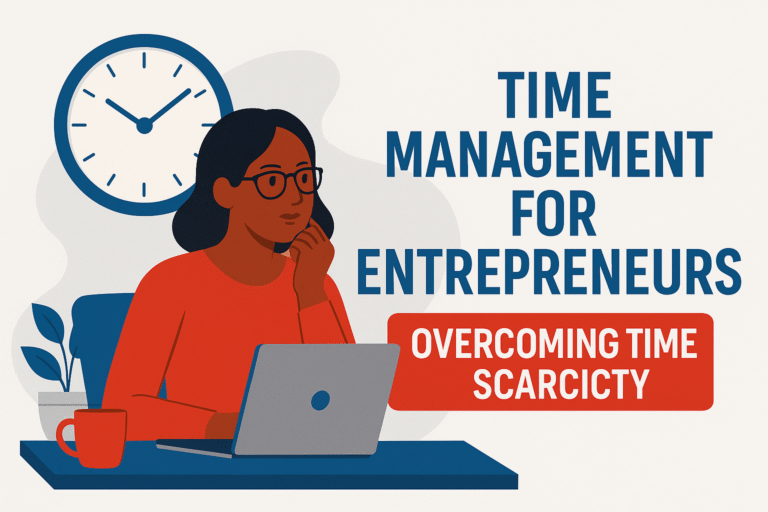CEO Mindset Mondays
How to be your own boss isn’t just about launching a business—it’s about reclaiming responsibility for your future, especially when no one else will.
I used to think like an employee. I was comfortable letting someone else make the financial calls. Back when I worked as a business advisor at the SBDC, our director once asked the team for ideas to improve our department’s financial situation—and I didn’t want to deal with it. I just wanted to do my job, help clients start businesses, get the funding they needed to thrive, and move on. As long as I got my paycheck, I was good.
But then I got laid off—for the second time in my life. And suddenly, finances were a big issue. I’d gotten cushy, relying on someone else with no backup plan. Since then, even in employment roles I’ve loved, there’s always been a low buzz of fear: What if this ends too?
That’s when I realized—my employee mindset had stopped serving me. And that realization is where this shift begins.
The truth? Becoming your own boss starts long before filing the paperwork. It starts in your mind—with the moment you decide to lead.
The Employee Script We’re Trained to Follow
Most of us don’t notice it at first. The employee mindset is subtle—quiet, even comforting. It rewards you for following the rules, deferring to authority, and staying within the lines. It tells you things like:
“Don’t rock the boat.”
“Wait your turn.”
“Let someone else handle the hard parts.”

And when you’ve been in the workforce long enough, that script starts to feel like truth. You get used to having decisions made for you—budgets, priorities, direction. Even when things don’t make sense, it’s easier to shrug and say, “That’s above my pay grade.”
I did it too. I built expertise, delivered results, and still felt like my job was to stay in my lane. That mindset served me well… until it didn’t.
I tried to take initiative, but I got so much pushback that I started shrinking. My opinions were devalued. I’d hear things like, “I’ve been here for six years. I think I know better than you.” I was stuck in stagnation. The moment I tried to offer something new, I’d be hit with, “This is the way we’ve always done it.” Or worse—I was simply ignored. I’d raise the same ideas again and again, and no one responded. But the moment someone else said it? Suddenly it was heard. Recognized. Acted on.
That kind of environment doesn’t just limit your growth—it chips away at your belief that growth is even possible.
And when you finally decide to figure out how to be your own boss, that script becomes a trap. You can’t wait to be told what matters. You have to decide what matters—and own it.
That’s when everything changes.
The Identity Shift: From Worker to Visionary
There’s a moment when you realize the issue isn’t just the job—it’s how the job has shaped your thinking.
When I stepped into entrepreneurship, I didn’t call myself a CEO. Honestly, I didn’t even call myself a business owner. I’d say things like, “I’m working on a project” or “I’m starting a business.” Not because that was the most accurate description—but because I didn’t want to sound like a failure.
My business wasn’t where I wanted it to be. I didn’t have the client base I imagined. And if I told people I was running a business, I was afraid they’d start asking questions I didn’t want to answer. So I kept it quiet—something only my close friends and family knew about.
But in hindsight? That was a disservice to my business.
No one wants to invest in a “project” or a “hobby.” They want to invest in a business. In a founder who’s proud of what they’re building and confident about where they’re headed. Learning how to be your own boss means showing up like you believe in the thing you’re offering—even before it’s perfect, even before it’s profitable.
The mindset shift happens when you stop calling it “something you’re working on” and start saying: I own a business. I help people with [XYZ].
It’s not just about changing the language. It’s about believing that what you’re doing matters enough to be taken seriously—and that starts with you.
Confidence Isn’t Magic—It’s Muscle
 Some people make confidence look effortless. They speak about their business like it’s already successful, already proven. I used to think they had something I didn’t—that maybe they were just born more self-assured.
Some people make confidence look effortless. They speak about their business like it’s already successful, already proven. I used to think they had something I didn’t—that maybe they were just born more self-assured.
But I’ve learned something: confidence isn’t magic. It’s muscle. And like any muscle, it grows when you use it.
The funny thing is, I’d forgotten I already had the know-how. I had been successful in another arena—as an employee. That didn’t disappear just because I had a new title. I had already gained traction with my blog. People were engaging with the content. They cared about what I had to say. That didn’t vanish the moment I became a business owner. If anything, it validated me.
So why did I still doubt myself?
It’s the same for so many new founders. You get so focused on what you haven’t done yet, you forget what you’ve already accomplished. But learning how to be your own boss means remembering your history—your skills, your results, your resilience.
In the beginning, even before you’ve officially launched, share your ideas. Get feedback. Let the validation build you. It’s not about waiting until everything’s perfect—it’s about letting your confidence grow alongside your progress.
And as you keep moving, don’t forget: you’re not starting from zero. You’re starting with experience. With perspective. With options. You can ask for help. You can lean into what you already know.
You don’t have to grow a business alone. But you do have to believe you’re allowed to grow one at all.
Small Moves That Build Big Belief
You don’t wake up one day and suddenly feel like a CEO. That identity builds over time—through small decisions that teach you how to trust yourself.
When I started showing up differently—claiming my work, not minimizing it—things shifted. Not overnight. But every time I said, “I run a business” instead of “I’m working on something,” I felt it get a little more real.
So if you’re figuring out how to be your own boss, don’t wait for a major milestone. Start with small moves that help you embody the role you’re growing into:
Use your title. Not someday—now. Say “I own a business” or “I’m the founder of [business name].” You don’t need permission to take up space.
Make a decision without asking for backup. You already know more than you think. Prove it to yourself.
Set a goal you’d be proud to complete. Something clear, time-bound, and rooted in who you’re becoming—not just what you’re doing.
 These small moments compound. Each one rewires your brain to see yourself not as an employee hoping for validation—but as a leader building something on purpose.
These small moments compound. Each one rewires your brain to see yourself not as an employee hoping for validation—but as a leader building something on purpose.
If you’re not sure what that next step should be, start by setting a SMART goal you can actually follow through on. Start Your Business with SMART Goals is one of the free tools I come back to again and again when I feel stuck or uncertain.
You Already Know How to Lead—Now You Need to Believe It
We talk about entrepreneurship like it’s a whole new world. And in some ways, it is. But the truth is, leadership isn’t new to you.
Think about the roles you’ve played in your life—at work, in your family, in your community. You’ve made decisions, guided others, handled setbacks. You’ve taken initiative, managed details, held things together when no one else did.
That is leadership. You’ve done it before. You just may not have called it that.
Learning how to be your own boss means realizing you don’t have to reinvent yourself—you just have to recognize what’s already there. You’ve led projects. You’ve supported clients. You’ve solved problems no one else wanted to deal with.
That version of you doesn’t disappear when you step into entrepreneurship. In fact, she’s the one you need to bring forward.
And if there’s something you don’t know yet? You can learn it. You can ask for help. You can grow into what your business needs.
But stop acting like you’re brand new just because your title changed. You already have leadership in you. It’s time to believe it—and build from it.
You’re the Only Approval You Need
There’s always going to be someone who doesn’t get it. Someone who thinks your business is a phase, a risk, a reach. But the real question isn’t what they believe.
It’s what you believe.
Because learning how to be your own boss isn’t about ticking off a list of business tasks. It’s about choosing to trust your own vision. It’s about seeing your value before anyone else validates it. It’s about deciding—today—that this isn’t just a “project.” It’s a business. And you’re the one leading it.
I’ve spent years unraveling the mindset that told me to wait. To soften. To hide. And I still have moments where I catch myself playing small. But I’ve learned how to pause, remind myself who I am, and step back into the role I chose: business owner, founder, CEO.

If you’ve been waiting for someone to tell you you’re ready, let this be it.
You are.
👉 Want help stepping into the CEO mindset? Download the free CEO Mindset Mini-Guide and start showing up like the leader your business needs.






